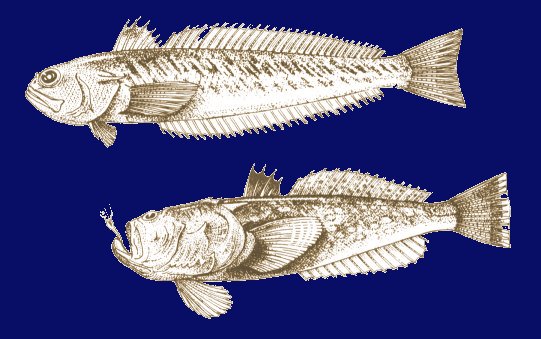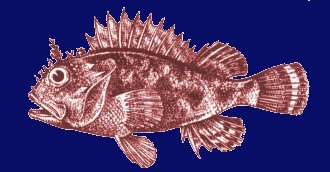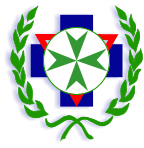The class Pisces incorporates a number of
species which could be hazardous to man. The presented hazard could
result either by virtue of their size causing severe bite injuries e.g.
sharks ; or by
virtue of their being inedible
; or by
virtue of their being inedible ; or by
virtue of their defense mechanisms which incorporate poison glands.
; or by
virtue of their defense mechanisms which incorporate poison glands.
Order Batoidei - Family Rajidae: Rays and skates
 These
fish live chiefly on or near the bottom. The body is very flat, with a
long thin tail which is clearly demarcated from it. The tail may carry
a poisonous sting. The spines of the stingray are situated on the rear
half of the tail. There are toxic glands, from which a slimy secretion
is passed through longitudinal grooves along the spines. These spines
often cause deep wounds, which are painful in themselves. Since the
spines will often break off in the wound, they are difficult to heal.
The species generally encountered in Maltese waters is the Common
Stingray Dasybatus pastinachus.
These
fish live chiefly on or near the bottom. The body is very flat, with a
long thin tail which is clearly demarcated from it. The tail may carry
a poisonous sting. The spines of the stingray are situated on the rear
half of the tail. There are toxic glands, from which a slimy secretion
is passed through longitudinal grooves along the spines. These spines
often cause deep wounds, which are painful in themselves. Since the
spines will often break off in the wound, they are difficult to heal.
The species generally encountered in Maltese waters is the Common
Stingray Dasybatus pastinachus.
 Belonging to the Family Torpedinidae, the Common Torpedo Torpedo torpedo has electric organs
on both sides of the body, which enable the fish to defend itself with
a relatively strong discharge [about 70-80 volts]. The attack is in
itself harmless to man, but unpleasant enough for divers and fishermen
to avoid it.
Belonging to the Family Torpedinidae, the Common Torpedo Torpedo torpedo has electric organs
on both sides of the body, which enable the fish to defend itself with
a relatively strong discharge [about 70-80 volts]. The attack is in
itself harmless to man, but unpleasant enough for divers and fishermen
to avoid it.
Family Trachinidae:
Weaver fish
Family Uranoscopidae:
Stargazer
 These fish live on the bottom usually buried in the sand
and mud. They are notorious for their poison spines. The weavers spawn
in the hot summer months, when they bury themselves in the sand or
mudsurf, leaving erected the black first dorsal ray equipped with the
venomous spines well visibly exposed. When the fish is disturbed, such
as when accidentally treaded upon they become aggressive and defend
themselves by stinging the unwary intruder with their needle sharp
spines. On rare occasions as well, they are known to have actually
attacked swimmers, harpoonists, and snorklers. The araneus species can
be found in water even 100 meters in depth. The smaller weavers tend to
come inshore and can be found in water only a few inches deep. They can
be caught by rod-fishermen, but more commonly by the various netting
methods and trawlings. Harpooning a weaver constitutes a real hazard,
as the injured fish becomes very aggressive and its removal from the
spear is rather tricky and difficult as regards avoiding self injury.
The Trachinidae remain alive out of sea for quite a long time and one
has to remember that their spines remain poisonous even after the fish
dies. It is therefore quite a usual practice for the spines to be cut
and removed by fishermen or fishmongers as a precaution both to
themselves and to their customers. The culinary food value of weaver
and commensibility is quite good. Several species are known in Maltese
waters: Tachinus vipera; Trachino draco; Tachinus lineatus; and Tachinus araneus. Closely related
to the Trachinididae is the
Stargazer Uranoscopus scaber.
These fish live on the bottom usually buried in the sand
and mud. They are notorious for their poison spines. The weavers spawn
in the hot summer months, when they bury themselves in the sand or
mudsurf, leaving erected the black first dorsal ray equipped with the
venomous spines well visibly exposed. When the fish is disturbed, such
as when accidentally treaded upon they become aggressive and defend
themselves by stinging the unwary intruder with their needle sharp
spines. On rare occasions as well, they are known to have actually
attacked swimmers, harpoonists, and snorklers. The araneus species can
be found in water even 100 meters in depth. The smaller weavers tend to
come inshore and can be found in water only a few inches deep. They can
be caught by rod-fishermen, but more commonly by the various netting
methods and trawlings. Harpooning a weaver constitutes a real hazard,
as the injured fish becomes very aggressive and its removal from the
spear is rather tricky and difficult as regards avoiding self injury.
The Trachinidae remain alive out of sea for quite a long time and one
has to remember that their spines remain poisonous even after the fish
dies. It is therefore quite a usual practice for the spines to be cut
and removed by fishermen or fishmongers as a precaution both to
themselves and to their customers. The culinary food value of weaver
and commensibility is quite good. Several species are known in Maltese
waters: Tachinus vipera; Trachino draco; Tachinus lineatus; and Tachinus araneus. Closely related
to the Trachinididae is the
Stargazer Uranoscopus scaber.
 Family
Scorpaenidae: Scorpion Fish
Family
Scorpaenidae: Scorpion Fish
<>The spiny rays in the dorsal fin and gill flap spines of the
Scorpion Fish species are poisonous. The species are often found on
rocky ground among the algae or over sand from 10 m depth. Several
species are known from Maltese waters including
Scorpoena porcus;
Scorpoena scrofa;
Scorpoena ustulata; and
Helicolenus dactylopterus.
Clinical
Features:
With injection of
the toxin, the sting of the poisonous fish causes an immediate severe
stinging or throbbing pain which may stay at the site of the wound or
spread throughout the body and last for several hours or days. Reaction
varies from person to person. Most Stingray wounds are found on
the ankle or foot and may be more of a laceration than a wound; while
the plantar aspect is the most frequent site for Weaver or Scorpion
fish stings. There may be redness and swelling at the site of the
sting, and the area may become numb, followed by dizziness, weakness,
cramps, sweating and falling blood pressure.
Treatment:
The treatment of fish sting poisoning is largely empirical, there is no
known antidote.
- Denaturing
the toxin
- Alleviation
of pain.
- Counteracting
allergic manifestations
- Prevention
of secondary infections.
For the less toxic species:-
- As first
aid, it is essential to clean the wound thoroughly with fresh or salt
water and sucked out.
- The affected
area should be soaked in hot water or covered with a hot compress. The
water should be very hot (circa 122 F), so that the heat will
deactivate the poison.
- Strong
analgesics may need to be given, but the injection of 2 ml of 2%
lignocaine immediately on and around the puncture wound may suffice.
- It is
essential to avoid infection of the wound, and antibiotics should be
used. Lacerations should, if necessary, be closed surgically and
cleaned with antiseptics. Tetanus shots should also be administered for
those who are not previously immunized.
For the more toxic species:-
- Continue
applying hot water for 30 minutes to an hour.
- The patient
should lie still with the stung part immobile and lower than the heart.
Tie a venous tourniquet around a stung limb two or four inches above
the sting. If the swelling reaches the band, tie another venous
tourniquet two or four inches higher up and remove the first one.
- Allergic
manifestations are dealt with the usual antihistaminic drugs such as
Piriton, Phenerghan and Tavegyl, but local injection of epinephrine and
subsequent use of neostigmine has been suggested for the management of
severe toxic species poisoning.
- Mechanical
ventilation and measures to combat shock may be needed in
hypersensitive cases.
Generally,
victims recover within 48 hours, although hospitalization may be
required for those with persistent symptoms of chest pain, irregular
pulse or hypotension.







 These
fish live chiefly on or near the bottom. The body is very flat, with a
long thin tail which is clearly demarcated from it. The tail may carry
a poisonous sting. The spines of the stingray are situated on the rear
half of the tail. There are toxic glands, from which a slimy secretion
is passed through longitudinal grooves along the spines. These spines
often cause deep wounds, which are painful in themselves. Since the
spines will often break off in the wound, they are difficult to heal.
The species generally encountered in Maltese waters is the Common
Stingray
These
fish live chiefly on or near the bottom. The body is very flat, with a
long thin tail which is clearly demarcated from it. The tail may carry
a poisonous sting. The spines of the stingray are situated on the rear
half of the tail. There are toxic glands, from which a slimy secretion
is passed through longitudinal grooves along the spines. These spines
often cause deep wounds, which are painful in themselves. Since the
spines will often break off in the wound, they are difficult to heal.
The species generally encountered in Maltese waters is the Common
Stingray  Belonging to the Family
Belonging to the Family  These fish live on the bottom usually buried in the sand
and mud. They are notorious for their poison spines. The weavers spawn
in the hot summer months, when they bury themselves in the sand or
mudsurf, leaving erected the black first dorsal ray equipped with the
venomous spines well visibly exposed. When the fish is disturbed, such
as when accidentally treaded upon they become aggressive and defend
themselves by stinging the unwary intruder with their needle sharp
spines. On rare occasions as well, they are known to have actually
attacked swimmers, harpoonists, and snorklers. The araneus species can
be found in water even 100 meters in depth. The smaller weavers tend to
come inshore and can be found in water only a few inches deep. They can
be caught by rod-fishermen, but more commonly by the various netting
methods and trawlings. Harpooning a weaver constitutes a real hazard,
as the injured fish becomes very aggressive and its removal from the
spear is rather tricky and difficult as regards avoiding self injury.
The Trachinidae remain alive out of sea for quite a long time and one
has to remember that their spines remain poisonous even after the fish
dies. It is therefore quite a usual practice for the spines to be cut
and removed by fishermen or fishmongers as a precaution both to
themselves and to their customers. The culinary food value of weaver
and commensibility is quite good. Several species are known in Maltese
waters:
These fish live on the bottom usually buried in the sand
and mud. They are notorious for their poison spines. The weavers spawn
in the hot summer months, when they bury themselves in the sand or
mudsurf, leaving erected the black first dorsal ray equipped with the
venomous spines well visibly exposed. When the fish is disturbed, such
as when accidentally treaded upon they become aggressive and defend
themselves by stinging the unwary intruder with their needle sharp
spines. On rare occasions as well, they are known to have actually
attacked swimmers, harpoonists, and snorklers. The araneus species can
be found in water even 100 meters in depth. The smaller weavers tend to
come inshore and can be found in water only a few inches deep. They can
be caught by rod-fishermen, but more commonly by the various netting
methods and trawlings. Harpooning a weaver constitutes a real hazard,
as the injured fish becomes very aggressive and its removal from the
spear is rather tricky and difficult as regards avoiding self injury.
The Trachinidae remain alive out of sea for quite a long time and one
has to remember that their spines remain poisonous even after the fish
dies. It is therefore quite a usual practice for the spines to be cut
and removed by fishermen or fishmongers as a precaution both to
themselves and to their customers. The culinary food value of weaver
and commensibility is quite good. Several species are known in Maltese
waters:  Family
Scorpaenidae: Scorpion Fish
Family
Scorpaenidae: Scorpion Fish